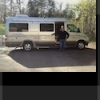
The Tumalo Lavender Farm is located just outside of Bend, Ore., and is a 10-acre garden filled with the sweet fragrance of 10,000 mature plants, all grown organically, pollinated by some very busy bees. It is a labor of love for Gordon and Judy Knight, who – a decade ago – left professional careers in the travel industry to follow their heart’s desire to be surrounded by beautiful and practical lavender.
Here’s a video of our tour:
Gordon, accompanied by Jazzmine, their Golden Retreiver and the official greeter at the farm, took time from his cuttings and planting and gave us a tour of the farm. Before deciding to become Lavender farmers, they spent three years researching, investigating, and reading extensively about lavender. Their quest took them to Lavender farms throughout the Northwest. They became knowledgeable in growing, processing and working with lavender. They found the right varieties that would adapt and survive in the climate of Central Oregon.
Tumelo Lavender now ships its plants and the many products made from them across the nation through direct order from nurseries and over the Internet through its website. I was amazed at the many ways Lavender can be used. Lavender is not only beautiful and sensory, but a practical choice for a garden.I bought two potted plants to take home.
Lavender is easy to grow and has a reputation for being notoriously non-palatable to deer. It is also considered a drought-tolerant plant and Gordon assured me it will thrive in our Michigan climate.
Pleasant scents can put you in a peaceful state of mind. Lavender has been associated with cleanliness since Romans first added it to their bathwater. In fact, the name comes from the Latin lavandus, meaning to wash. Essential oil of lavender is now known to have many application in aromatherapy. Lavender was traditionally inhaled to ease exhaustion, insomnia, irritability, and depression. In ancient times, it was used as a medicine. Gordon told us that a local hospital in Bend buys his plants and uses them to cam surgery patients before they are administered anesthetic.
Lavender is a favorite for scenting clothing and closets, soaps, and even furniture polish.
The calming, fresh, unique fragrance of lavender is available in potpourris, buds, oils, handmade soap, lotions, lip balm, and hydro-mists and wreaths.
While Mike was shooting video, I did some shopping. The smell of lavender will be a welcome addition to our RV. I bought a lot of lavender, for gifts and for our motorhome. We’ve been on the road a long time this season and the lavender will do wonders.
- Read more...
- 1 comment
- 1965 views

